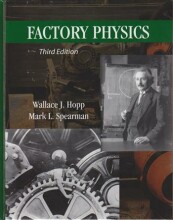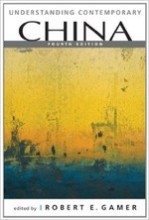Summary: Factory Physics | 9781577667391 | Wallace J Hopp
- This + 400k other summaries
- A unique study and practice tool
- Never study anything twice again
- Get the grades you hope for
- 100% sure, 100% understanding
Read the summary and the most important questions on Factory Physics | 9781577667391 | Wallace J. Hopp
-
2 Inventory Control
This is a preview. There are 1 more flashcards available for chapter 2
Show more cards here -
What is the key insight of EOQ
There is a tradeoff between lot size and inventory
-
What is the difference between the base stock and the Q r inventory models
in the q,r model the ordering costs are non-negligible
-
How did Harris (1913) defined the sum of the labor and material costs to ready the shop to produce a product?
Setup cost
-
2.2 The Economic Order Quantity Model
This is a preview. There are 4 more flashcards available for chapter 2.2
Show more cards here -
Consider figure 2.1. To which assumptions can the vertical lines at intervals nQ/D (with n = 1, 2, 3 ... n) be attributed? (Why are they vertical?)
Assumption 1 & 2. The vertical line represents instantaneous production and immediate delivery, and more so, a perfect overlap and similar timing between them.
-
How is assumption 4 represented in figure 2.1?
Assumption 4: represented in the oblique lines. Since demand is constant over time, the inventory level decreases constant over time as well, resulting in an oblique line.
-
Based on the 6 assumptions, figure 2.1 should actually be incorrect. How? What extra assumptions are made here?
According to assumption 6, products can be analyzed individually. This means that the oblique lines in figure 2.1 should actually not be smooth. Instead, inventory should be decreasing incrementally.
For modeling purposes, time and product are represented as continuous quantities. -
A manager calculates an optimal order quantity Q* = 23,4 for product X, with an optimal order interval T* = 2,6 weeks. Yet he decides to order every 2 weeks in order quantity Q'. What is Q', what are the effects on the costs and what could be the reason for the manager to use this different strategy?
D = Q* / T* = 9 products per week. Q' = T' ⋅ D = 2 ⋅ 9 = 18 products.
Effect on costs (see 2.2.4): Y(Q')/Y* = 0,5 (Q'/Q* + Q*/Q') = 1,035. This means a 3,5% increase in costs.
Reason: to order items at intervals given by powers of 2 to facilitate the sharing of resources in a multi-product environment (e.g. delivery trucks)
-
In 2.2.3 a key insight is presented as: 'there is a tradeoff between lot size and inventory'. Does this mean lot size goes down as inventory goes up?
No, a larger lot size leads to a larger inventory. A larger lot size leads to a lower order frequency. This means that a higher order frequency leads to lower lot sizes and lower inventory levels. There are decreasing returns however, as shown in figure 2.3.
-
Give the expression for the total (inventory, setup, and production) cost per year with relation to the EOQ model
Y(Q) = ((hQ)/2)+((AD)/Q) + cD = ((icQ)/2)+((AD)/Q) + cD
-
For which lot size Q is the total annual cost Y(Q) minimized?
For the value of Q for which the holding cost and setup cost are exactly balanced (i.e. the hQ/D and AD/Q cost curves cross).
- Higher grades + faster learning
- Never study anything twice
- 100% sure, 100% understanding
Topics related to Summary: Factory Physics
-
INventory - Statistical Inventory Models
-
INventory - Appendix 2A: Basic Probability
-
The MRP Crusade - Material Requirements Planning - MRP
-
From the JIT Revolution to Lean Manufacturing - JIT Goals
-
From the JIT Revolution to Lean Manufacturing - Implementing JIT
-
What Went Wrong? - The Problem
-
What Went Wrong? - The Solution
-
What Went Wrong? - The Rise of the Computer
-
A Science of Manufacturing - The seeds of science
-
A Science of Manufacturing - Formal Roots
-
A Science of Manufacturing - Strategic and Operational Objectives
-
A Science of Manufacturing - Models and Performance Measures
-
Basic Factory Dynamics - Definitions and Parameters
-
Basic Factory Dynamics - Simple Relationships
-
Basic Factory Dynamics - Labor-Constrained Systems
-
Variability Basics - Variability and Randomness
-
Variability Basics - Process Time Variability
-
Variability Basics - Causes of Variability
-
Variability Basics - Flow Variability
-
Variability Basics - Variability - Queueing
-
Variability Basics - Effects of Blocking
-
The Corrupting Influence of Variability - Variability Laws
-
The Corrupting Influence of Variability - Flow Laws
-
The Corrupting Influence of Variability - Batching Laws
-
The Corrupting Influence of Variability - Cycle Time
-
The Corrupting Influence of Variability - Performance and Variability
-
The Corrupting Influence of Variability - Diagnostics and Improvements
-
Push and Pull Production Systems - Perceptions of Pull
-
Push and Pull Production Systems - The Magic of Pull
-
Push and Pull Production Systems - CONWIP
-
Push and Pull Production Systems - Comparisons of CONWIP with MRP
-
Push and Pull Production Systems - Comparisons of CONWIP with Kanban
-
Total Quality Manufacturing - Quality and Operations - Quality Supports Operations
-
A Pull Planning Framework - Disaggregation
-
A Pull Planning Framework - Forecasting
-
A Pull Planning Framework - Planning for Pull
-
A Pull Planning Framework - Hierarchical Production Planning
-
Shop Floor Control - Introduction
-
Shop Floor Control - General Considerations
-
Shop Floor Control - CONWIP Configurations
-
Shop Floor Control - Other Pull Mechanisms

































